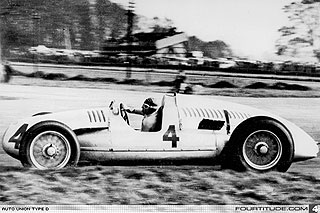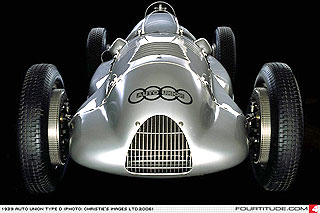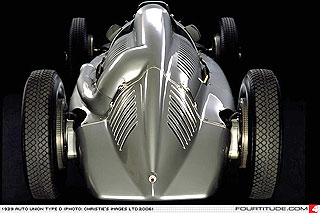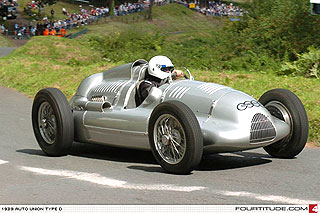1939 Auto Union Type D Expected to Fetch Highest Price Ever for Car in February '07 Auction
One of Two Original Auto Union Type D Silver Arrow Racecars Known to Exist.
That an original 1939 Auto Union Type D racecar will be auctioned is no small matter. These racecars, with engineering by Ferdinand Porsche, are some of the greatest racing cars in history, and also some of the rarest with only two original Type D racecars known to exist. For that reason, the auction house or record Christie’s suggests that this Auto Union will break the record for the most expensive automobile ever sold.
The ‘Silver Arrow’ era is arguably one of the greatest eras in racing history. With mobilization as a major goal for his country and successful race teams and race drivers a major source of national pride for the masses, Nazi leader Adolph Hitler funded the development of ground-breaking racecar design from Auto Union (the precursor to Audi AG as we know it today) and Mercedes-Benz. The Auto Unions in particular were revolutionary in design, masterminded by the great Ferdinand Porsche. Porsche was the first to place the engine amidships in a racecar, with the driver in the front for better balance. The cars also featured fully independent de Dion suspension. Earlier Type A, B and C Auto Unions featured a supercharged 16-cylinder engine that was later changed to a supercharged 12-cylinder for the 1938 race season to meet new international Grand Prix regulations that restricted the displacement of the engine to three liters. By this time, the Porsche had left the Auto Union project and adaptation of his basic design to meet the new regulations was supervised by Robert Eberan-Eberhorst. Drivers of the Type D models included Tazio Nuvolari, Hans Stuck, H.P. Muller, Georg Meier and Rudolf Hasse.
The Auto Unions in particular were revolutionary in design, masterminded by the great Ferdinand Porsche. Porsche was the first to place the engine amidships in a racecar, with the driver in the front for better balance. The cars also featured fully independent de Dion suspension. Earlier Type A, B and C Auto Unions featured a supercharged 16-cylinder engine that was later changed to a supercharged 12-cylinder for the 1938 race season to meet new international Grand Prix regulations that restricted the displacement of the engine to three liters. By this time, the Porsche had left the Auto Union project and adaptation of his basic design to meet the new regulations was supervised by Robert Eberan-Eberhorst. Drivers of the Type D models included Tazio Nuvolari, Hans Stuck, H.P. Muller, Georg Meier and Rudolf Hasse.
This particular Auto Union chassis, chassis #21 according to sources at Audi Tradition, is reported by Christie’s to have won the 1939 Grand Prix at the talented hand of “The Flying Mantuan”, the legendary Tazio Nuvolari. Audi Tradition also reports that this chassis won the 1939 Grand Prix of France in Reims by driver H.P. Muller. Another interesting aspect of racing during that period is provided by Audi Tradition, and suggests why it is hard to pinpoint the exact history of a given silver arrow from the era. According to our source, both Auto Union and Mercedes-Benz employed the practice of the ‘Driver Car’ or ‘Winner Car’ whereby all of the components were pulled from the cars after a race and re-installed in the cars for the next race, and not uncommonly mixed from chassis to chassis.
Another interesting aspect of racing during that period is provided by Audi Tradition, and suggests why it is hard to pinpoint the exact history of a given silver arrow from the era. According to our source, both Auto Union and Mercedes-Benz employed the practice of the ‘Driver Car’ or ‘Winner Car’ whereby all of the components were pulled from the cars after a race and re-installed in the cars for the next race, and not uncommonly mixed from chassis to chassis.
Original Auto Union racecars are the rarest of breeds. While many of these cars were built and campaigned by Auto Union in the years prior to World War II, the legendary Auto Union silver arrows fell on a harder fate than their counterparts from Mercedes-Benz, Auto Union and its several facilities, including its Zwickau headquarters ended up behind the Iron Curtain when the geopolitical divider dropped.
It is said Auto Union staff did their best to hide the cars from the Russians, squirreling eighteen of these legendary machines away in a mineshaft, though the cars were eventually discovered by the Russians and shipped by train back to Russia to be examined for their technology. Only two Type D racecars are known to have survived, though a very small number of display cars that were never raced are also in the hands of a very select group of collectors. For many years, the components of this particular car and several others sat, largely dismantled, within the borders of the Soviet Union. It and what amassed to two or three others were located there in pieces, the bodies separated from the chassis and marked for the scrap heap when they was saved by the American Paul Karassik who found the stash in the mid 1980’s.
For many years, the components of this particular car and several others sat, largely dismantled, within the borders of the Soviet Union. It and what amassed to two or three others were located there in pieces, the bodies separated from the chassis and marked for the scrap heap when they was saved by the American Paul Karassik who found the stash in the mid 1980’s.
From Russia, the Auto Union chassis and parts were shipped west to England where the body of this Type D was recreated by Rod Jolley Coachbuilding and made to the exact dimensions of the original. Following this process, this ’39 Type D and a second ’38 Type D were rebuilt and fully restored by Crosthwaite and Gardiner, the same company who would later recreate in exact detail additional Auto Union silver arrow replicas for Audi AG and is reported to be currently creating an exact replica of the ’39 Type D for the Audi Tradition collection. In 1994, Dick Crosthwaite track tested this restored Auto Union for the first time following its reassembly at the fabled Nurburgring, from whence it was sold by Karassik to an English owner, all the time being meticulously maintained according to Christie’s. The other Auto Union Type D with racing pedigree known to exist, saved by Karassik and rebuilt by Crosthwaite and Gardiner is a 1938 example owned by Audi AG, kept as part of the Audi Tradition collection and recently displayed at the Audi Forum New York City last October. The 1939 iteration set to be auctioned features an engine with dual superchargers good for 485 hp versus Audi’s ’38 Auto Union that features a single supercharger and 420 hp. Further differences between the ’38 and ’39 cars can also be spotted by the well-trained eye, including a different hunchback design at the rear, modified so that the car could accept the second supercharger underneath the aluminum bodywork.
The other Auto Union Type D with racing pedigree known to exist, saved by Karassik and rebuilt by Crosthwaite and Gardiner is a 1938 example owned by Audi AG, kept as part of the Audi Tradition collection and recently displayed at the Audi Forum New York City last October. The 1939 iteration set to be auctioned features an engine with dual superchargers good for 485 hp versus Audi’s ’38 Auto Union that features a single supercharger and 420 hp. Further differences between the ’38 and ’39 cars can also be spotted by the well-trained eye, including a different hunchback design at the rear, modified so that the car could accept the second supercharger underneath the aluminum bodywork.
The 1939 Auto Union Type D is slated to go under the auctioneer’s gavel on February 17, 2007 as a lot within the Christie’s International Motor Cars auction at Paris’ Retromobile 2007, one of Europe’s most prestigious vintage automobile exhibitions.
In late January of 2007, sources at Audi have shared that the 1939 Auto Union will be air-freighted to New York City where it will be displayed for one or two days at the Audi Forum New York City so that Americans interested in viewing the car before it goes on sale in February can take a closer look at the car on their own soil, then be able to bid via Christie’s New York offices on the day of the auction should they be interested in doing so. Christie’s expects this Type D will sell for upwards of $12 million. If so, that will break the previous record of roughly $11 million paid in 1987 for a 1931 Bugatti Type 41 Royale Sports Coupe.
Christie’s expects this Type D will sell for upwards of $12 million. If so, that will break the previous record of roughly $11 million paid in 1987 for a 1931 Bugatti Type 41 Royale Sports Coupe.
Other significant vintage automobiles expected to be sold alongside the 1939 Auto Union Type D include a 1951 Talbot Lago T26GS "Barquette" driven single-handedly by Pierre Levegh in the 1952 24 Hours of Le Mans, a one-owner 1936 Mercedes-Ben 540K A, a 1927 Amilcar MCO with six speed records as claim to fame, the only remaining 1930 Derby K4 Low-Chassis Roadster and a nearly 100-piece pedal car collection.
Public Auction: Friday 16 and Saturday 17 February, Retromobile, Paris
Public Information: +33 (0)1 40 76 83 76 / +44-(0) 20 7389 2133 / www.christies.com
© Source: article on fourtitude.com